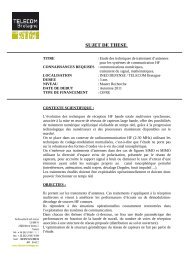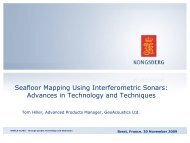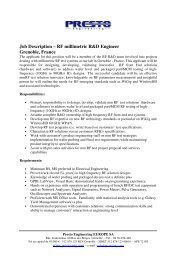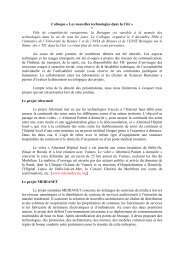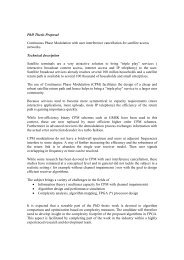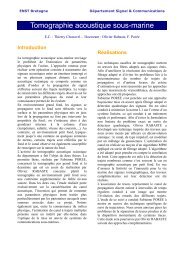Département Réseau, Sécurité et Multimédia Rapport d'Activités 2008
Département Réseau, Sécurité et Multimédia Rapport d'Activités 2008
Département Réseau, Sécurité et Multimédia Rapport d'Activités 2008
Create successful ePaper yourself
Turn your PDF publications into a flip-book with our unique Google optimized e-Paper software.
Security & MobilityUse of a Context Transfer Protocol to reduce operational cost ofaccess controlResearch Staff : Jean-Marie Bonnin – Ph.D. students: Fabien AllardKeywords : h<strong>et</strong>erogeneous access n<strong>et</strong>works, seamless handover, secured handover, contexttransfer, IPsec, PANAApplications : mobile operator n<strong>et</strong>worksPartners & Funding : CIFRE France Telecom R&DIntroductionWhen moving, a wireless user may need toswitch from an access point to another one.The radio link is generally secured(authentication of the user, ciphering,…) andthe same level of security must be kept afterany kind of handover. Two solutions may beused: s<strong>et</strong>ting up a new secured link during thehandover or transferring security informationto re-establish security context."Context transfer" refers to a technique inwhich information regarding a mobile terminalis transferred in the infrastructure n<strong>et</strong>workb<strong>et</strong>ween two points of attachment. The goal isto avoid service disruption due to time neededto re-establish the context in the new point ofattachment during a handover. The contexttransfer mechanism is particularly suited forsecurity services.The goal of this work is to implement a securehandover schemes based on the contexttransfer protocol defined by IETF and thencompare it with pre-authentication-basedsolutions through simulation and actual testbed.This work contributes to the DAIDALOS IIEuropean project.RealizationThe principle of the context transfermechanism is the following: when a mobilenode moves to a new access equipment, itneeds to continue flows that have alreadybeen established at the previous accessequipment. These services are known as"context transfer candidate services". We limitour scope to context related to security, likeIPsec, PANA, 802.1X, <strong>et</strong>c. and we mainly focuson the solution defined by the IETF: theContext Transfer Protocol (CXTP – RFC 4067)[1].We implementated IPsec context transfer withCXTP. An article on the IPsec context transferin a IPv6 mobility environment has beenpublished in the BWIA07 workshop and in theIJCNDS journal [3]. It presents the IPseccontexts and the test-bed where the IPseccontext transfer is implemented.For the DAIDALOS II European project, CXTPhas been fully implemented under OMNET++,in order to compare CXTP to preauthenticationmechanisms. Optimizations ofCXTP for intra and inter domain cases havebeen proposed in order to improve theprotocol security: improvement of theauthorization token management, decrease ofthe ‘domino effect’ vulnerability window size,interaction with PANA and IPsec regarding themobility protocol (NETLMM or MIPv6). A studyof the use of MOBIKE (another mobilitymanagement scheme) with CXTP has beenrealized. A security proof of CXTP in predictivemode (MIHO and NIHO cases) has been donein HLPSL using the AVISPA project tools [2].Regarding the implementation work, SPD(security policy database) context transfer hasbeen implemented and other improvementshave been done : automatic management ofthe mobile node and the access routers IPaddresses during the execution, inter processcommunication using signals, transfer andconfiguration of both contexts (i.e. SAD andSPD) in one execution. These improvementswere made in order to begin the last step ofthis implementation: the transfer of the IKEcontext. These works are done in the scope ofthe french-japanese collaborative projectNAUTILUS6.Pracom’s Annual Report <strong>2008</strong> 29




